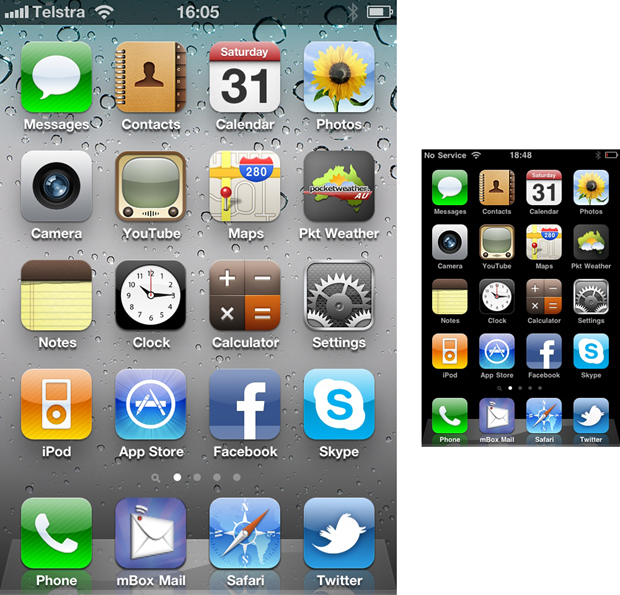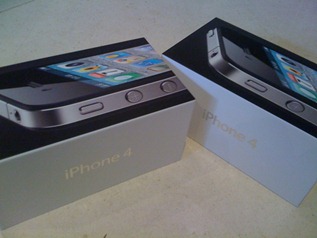 Yes, it’s the new iPhone 4. No, I didn’t camp outside Apple all night, there’s nothing wrong with the signal quality and yes, I hold it any damn way I like!
Yes, it’s the new iPhone 4. No, I didn’t camp outside Apple all night, there’s nothing wrong with the signal quality and yes, I hold it any damn way I like!
Now that we’ve covered off all the usual questions, let me get to the heart of the matter. I picked up a couple of new iPhones (because I’m a caring husband!) a few hours after they launched in Australia.
Exclusivity doesn’t last long and whilst the novelty factor is still high, a lot of friends and family are asking “why?”. Why move from a perfectly good iPhone 3G? Does this new phone – the one with all the signal quality problems – really do anything that great?
Actually, it does. So here’s the guide for “mere mortals”, that is the folks who don’t think in binary and insist that the sky is not blue, rather #0000ff. This is the jargon free, grass roots, everyday account of why you want one of these little beauties.
That signal quality issue
The otherwise flawless launch of the phone in the US has been continually marred by reports that the signal quality falls apart as soon as you do something reckless. Like hold it the wrong way. The press got so bad that poor old Steve Jobs had to stand up and do his best to defend the product and claim nothing was any different to any other phone but because he’s a great guy, he’ll give everyone a free case anyway, just to help you stop touching the bits you shouldn’t be.
Apparently a lot of orders in Australia (and I assume other parts of the world as well), have been cancelled because of the bad press. We'll here’s what actually happens, at least what ours do on the Telstra network.
Here’s how the signal quality looks when sitting on the desk (note the 5 bars in the top left corner):
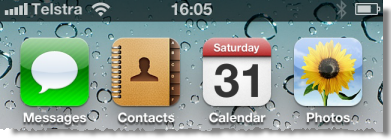
Here’s how it looks in the palm of my hand:

Here’s how it looks touching all the bits you’re not meant to:

And here’s how it looks in the “death grip” – both hands covering every part of the phone possible:

There is no signal problem. At least I don’t have any on either phone across five days of usage in a range of different locations and circumstances. Maybe the AT&T network (the sole carrier of the iPhone in the US) has dramas we don’t have in Australia. Maybe it just works better south of the equator, I have no idea. All I know is I don’t have any signal problems. Ever.
Until now. The previous paragraph was where this was meant to end and had I been organised enough to post this earlier today, everything would remain rosy. Unfortunately I got a call while getting changed this morning and whilst resting the phone between by ear and bare shoulder, the call dropped. And the bars dropped. And I could reproduce the problem. Granted, this is a pretty unique use case but it’s something I’m going to be keeping a close eye on for a bit.
Getting lots of pixels onto the screen
One of the headlines for the new phone is the improved picture quality. Apple make a song and dance about what they call the Retina Display which is primarily, but not exclusively, achieved by creating a display with a very high pixel density.
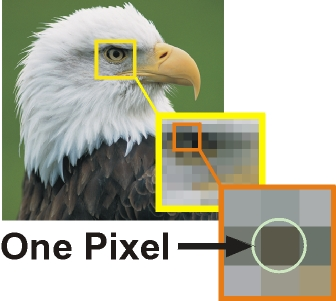 All displays – computer monitors, TVs, mobile phones – are made up of a series of very small blocks (pixels, in this case) in a grid. Each pixel displays a single colour which in the case of a device such as a modern computer monitor, could be any one of over 16 million different shades.
All displays – computer monitors, TVs, mobile phones – are made up of a series of very small blocks (pixels, in this case) in a grid. Each pixel displays a single colour which in the case of a device such as a modern computer monitor, could be any one of over 16 million different shades.
Because the blocks are both small and numerous, they’re barely distinguishable to the naked eye. A high definition TV running in 720p is 1,280 pixels wide by 720 pixels high (the resolution being 1280x720) so it fits 921,600 little coloured blocks onto the screen.
This is where the new iPhone starts to diverge from the old. Earlier models had a resolution of 320x480 whilst the iPhone 4 literally doubles the number of pixels in each axis and runs at 640x960. What this actually means in terms of total pixels is four times the resolution of the old model.
Let’s put that in perspective; following is a screen grab from the iPhone 4 on the left and the 3G on the right. This image is actually reduced by about a third to fit on the page. Click on the image and you’ll get a good sense of the difference:
The resolution is one thing, the actual size of the physical device though is critical as it determines the density of the dots. Since there’s no change in the physical size of the screen but you’re cramming in four times as many pixels, the display is really sharp. In fact the pixel density is so high, Apple claim that it’s passed the point where the human eye can distinguish the effect of individual pixels.
 What does this actually mean to use though? Photos have a lot more depth, that’s for sure, but the biggest difference in typography. Looking at black text on a white background, the characters are really sharp. In fact they’re so sharp – and so unfamiliar because no other device has this sort of pixel density at the moment – that it almost feels like the text is etched into the screen.
What does this actually mean to use though? Photos have a lot more depth, that’s for sure, but the biggest difference in typography. Looking at black text on a white background, the characters are really sharp. In fact they’re so sharp – and so unfamiliar because no other device has this sort of pixel density at the moment – that it almost feels like the text is etched into the screen.
The thing is though, there’s really no way of showing you just how good the display is because you’re reading this on a vastly inferior screen (probably similar to the one I’m typing this on!). You’ll just have to go and find (or buy) one and experience it firsthand.
Recording, editing and publishing video in high definition
One of the new features on the phone is a 5 mega pixel camera, up from 3 mega pixels in the old phone. What all these extra pixels do – beyond taking higher quality photos with the still camera – is allow high definition, 720p video to be taken. It’s the same camera app with similar functionality to before, it just has a little video toggle in the bottom corner now.
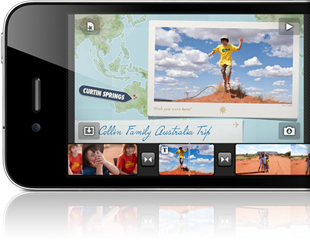 Recording video is great, but what next? You’ve got a couple of options; firstly you can send it via email or MMS directly from the camera roll or you can publish it straight to YouTube. This is great, but it’s taking the complete video in its original format.
Recording video is great, but what next? You’ve got a couple of options; firstly you can send it via email or MMS directly from the camera roll or you can publish it straight to YouTube. This is great, but it’s taking the complete video in its original format.
Apple have now released their own app into the App Store called iMovie. This brings basic video editing functionality right into the phone including the ability to crop and append clips, add titles and static photos, manage transitions and even overlay soundtracks. There are a few basic themes baked in (like the “Travel” theme in the image above) which give you a bit of variety in how the video looks and feels.
This is not a comprehensive video editing suite by any means, but consider what you can now do on this pocket sized device. While you’re out and about, you can record your clips, edit them on the fly, purchase a soundtrack from iTunes then overlay that and publish the whole thing to YouTube in HD. That, is pretty amazing!
Pretending you’re George Jetson, aka FaceTime
 Anyone remember the Jetsons? It was a cartoon series created back in the 60s which I still recall watching as a kid 20 years later. The idea was that the characters lived in a world 100 years ahead of where we actually were at the time and everything was rather futuristic.
Anyone remember the Jetsons? It was a cartoon series created back in the 60s which I still recall watching as a kid 20 years later. The idea was that the characters lived in a world 100 years ahead of where we actually were at the time and everything was rather futuristic.
I’ve now had my first true George Jetson moment with FaceTime. This is the technology that finally brings proper face-to-face video chat to the phone. You see, the iPhone 4 now has a tiny little camera facing forward so you can look at the screen while the phone looks back at you. Add in some fancy software and bingo, you’ve got video chat.
Because this is the mere mortals account of the device, let’s steer away from the technology that makes this happen and focus on the experience. First thing is that this is presently an iPhone 4 to iPhone 4 service. You can’t fire up Skype and FaceTime (I’m assuming this has become a verb already!) to someone on their iPhone. Apple talk about it being an “open protocol” with the objective of making it available on other devices but for now, you’ve got to have the latest iPhone.
The next thing is you must have a wifi connection at both ends. You can’t FaceTime over 3G. Assuming you are on wireless though, it’s a piece of cake. Either hit the “FaceTime” button on any contact in your address book or even hit the icon when you’re mid call over the normal GSM network (the image below left).
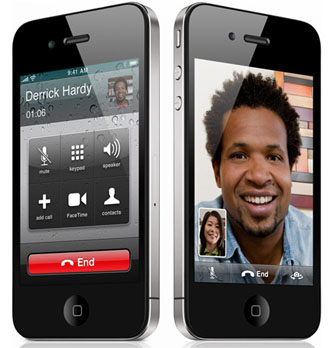
That’s it! You end up getting the above right screen on each end with your own picture embedded as a thumbnail in your friend’s picture. Turn the phone sideways and the picture rotates at the other end. Hit the little icon in the bottom right of the screen (above right picture) and the phone will switch to the rear camera so you can walk around and show your mate what you’re seeing.
Yes, its iPhone 4 only and yes there’s a wifi dependency but these are both solvable software problems. For now though, you’ll need to get some friends on board with the new phone to use it.
Sensing motion with the gyroscope
The previous generation iPhone had an accelerometer, and that was pretty neat. It meant the device knew which way it was being moved (or more strictly, which direction the motion was changing in) so it could do anything from measure the acceleration of a car to create games with basic motion awareness such as Labyrinth.
A gyroscope, on the other hand, measures orientation so it knows which way the device is rotated. A classic mechanical gyroscope looks something like the picture on the left:
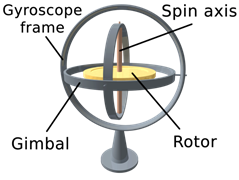
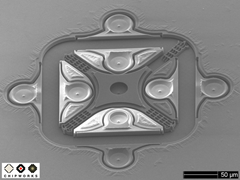
The iPhone 4 makes use of a microscopic, electronic version (there’s a fantastic “teardown” of it here) which sits on a chip in the phone, as see in the image above on the right. What it all means is that by having both an accelerometer and a gyroscope the phone can be put to all new uses relating to orientation and motion.
Let me give you an example; there’s a game by the name of N.O.V.A. getting some pretty positive press for its utilisation of iPhone 4 features. Now, you may be interested in the iPhone but not in games, but it’s a bit like being interested in high definition movies but not in the sex industry.
In each case, the breed has been significantly enhanced by these early adopters who have pushed the platforms along for the betterment of all users across a wide range of uses. Just have a look at how immersive this thing is and in particular, how the motion of the device is integral to the game play.
With all the features packed into the iPhone 4, the phone can now sense all of the following:
- Where you are (GPS)
- What direction you’re facing (compass)
- Which way you’re moving (accelerometer)
- The orientation of the device (gyroscope)
I’ve been a bit fortunate with the timing of this next piece; I was going to start waxing lyrical about all the wonderful potential these features had to create augmented reality style applications then low and behold, the Commonwealth Bank puts out an app this morning doing precisely what I was going to describe.
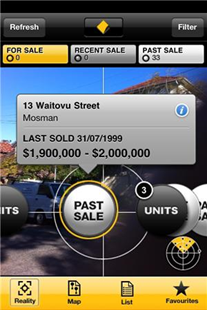 It’s called Property Guide and it literally allows you to walk down the street, point the phone at a house and get a bunch of info relevant to the potential home buyer. This includes information not just on how much the place has been listed for but you also get suburb demographics and previous sales price info from RP Data.
It’s called Property Guide and it literally allows you to walk down the street, point the phone at a house and get a bunch of info relevant to the potential home buyer. This includes information not just on how much the place has been listed for but you also get suburb demographics and previous sales price info from RP Data.
The augmented reality component is where the real power of the iPhone comes in; using the features bulleted above, the app turns on the rearward facing camera then overlays information on the picture as you can see in the image to the right. As you move the phone around to face different houses, the information on the screen follows the actual house shown by the camera (see the video in the link above for a sense of this).
This is amazingly cool to behold and has many, many potential uses for other applications in the future. It also runs on the 3GS (which has a compass) so it obviously doesn’t have a gyroscope dependency but is nonetheless a good illustration of what the more advanced hardware means for apps.
More power, more often
Apps like N.O.V.A. don’t come cheap in terms of the hardware resources they consume. The iPhone 4 brings a new processor (speed is up by about 30%) and double the memory of the 3GS (quadruple the 3G RAM).
Since the operating system for all iPhone was updated to iOS4 a little while back, those with a 3GS have had the ability to multi-task. The problem is, the old phone just isn’t very good at it. Actually, since upgrading to iOS4 many iPhone owners – including myself – have been dismayed at the poor performance. It actually got worse.
Admittedly, I don’t like the idea of buying a new iPhone because Apple screwed up the performance of my old one with a software update. That just doesn’t sit well with me. However, given I wanted all the new features anyway I got over my moral objections and the performance is now stunning.
The thing about the speed of the new phone is that it works as fast as I do. Don’t get me wrong, I’m not superhuman fast, I’m just impatient. I can’t stand waiting for something to happen after I click a button because its productivity straight out the window, especially if you repeat the task dozens of times a day.
In the iPhone 4, every task I commonly perform on the phone is as good as instantaneous (network dependencies aside). Running multiple apps and switching between them is absolutely seamless. Opening up most apps literally happens in a small fraction of a second. From a usability perspective, it’s an absolute joy to use and is chalk and cheese against the old phone.
Of course now that we have a much higher resolution display, another motion device to run, a faster processor, more memory and multi-tasking, the battery is going to take a real hammering. And this is on a phone already widely criticised for battery life.
Fortunately, Apple appears to have taken heed of the feedback. In the image below, you see an iPhone 4 on the left and an iPhone 3GS on the right (both courtesy of iFixit). The point of the images is to show that although the phones look somewhat similar on the outside, there are some fundamental differences on the inside.
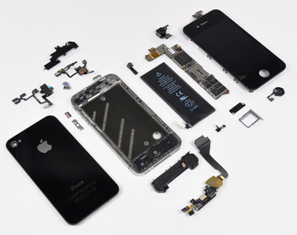
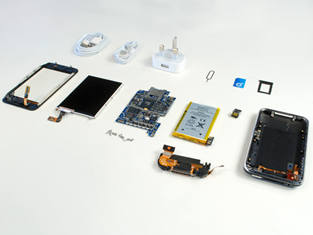
The main thing for battery life is that the internals of the phone have been significantly repackaged. You can see the battery in the left hand photo in the middle of the screen (you can just make out the CE logo) and on the right hand side with the yellow wrapper. The logic board (above the battery on the first image, to the left on the second one) has significantly changed in size and shape to make way for a chunkier battery promising some big improvements.
The feedback so far is very positive. Some websites are reporting up to 58% longer life depending on what you’re using it for (3G, wifi, talking, etc). To be honest, it’s a bit hard for me to comment because so far I’ve spent an above average amount of time playing with it and maxing out the sort of functionality that kills batteries very quickly. Still, improvements have obviously been made and I’m sure they’ll be well received.
Conclusion
Many of the features I touched on above are in other devices. Android is really heating up and Windows Mobile 7 is only a few months away. But this wasn’t intended to be a comparison, merely an answer for those who wondered “why?”.
Is it worth the upgrade? Well, if you can package the phone in with a plan from your telco and get it for nothing as I did, absolutely. We paid out a little on my wife’s plan for the early upgrade privilege and that was still worth it.
Would I pay A$850 for it outright when I already had a 3G? Hmmm, probably still yes but more because I’m a card-carrying techie and have that insatiable desire to have new and shiny electronics! If you fit into this category, then yes, go and get one. Now!
